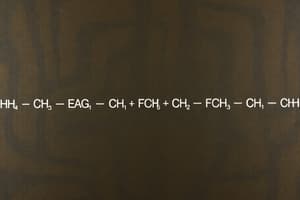Podcast
Questions and Answers
Atoms are made up of protons, neutrons, and electrons.
Atoms are made up of protons, neutrons, and electrons.
True (A)
Molecules may only be monatomic.
Molecules may only be monatomic.
False (B)
An atom is the smallest particle of an element.
An atom is the smallest particle of an element.
True (A)
Ar gas consists of diatomic molecules.
Ar gas consists of diatomic molecules.
Mass number is equal to the number of protons plus the number of electrons.
Mass number is equal to the number of protons plus the number of electrons.
Isotopes are atoms with the same atomic number but different mass numbers.
Isotopes are atoms with the same atomic number but different mass numbers.
Nonelectrolytes conduct electricity better than electrolytes.
Nonelectrolytes conduct electricity better than electrolytes.
Formulas of substances consist of symbols of elements with numerical subscripts.
Formulas of substances consist of symbols of elements with numerical subscripts.
Polyatomic ions do not have a superscript denoting their charge.
Polyatomic ions do not have a superscript denoting their charge.
In compound names, the nonmetal part always comes first.
In compound names, the nonmetal part always comes first.
Molarity is defined as the number of moles of solute in 1 liter of solvent.
Molarity is defined as the number of moles of solute in 1 liter of solvent.
Normality is the number of equivalents of solute in 1 liter of solution.
Normality is the number of equivalents of solute in 1 liter of solution.
Weight percent is commonly used to express volume concentrations.
Weight percent is commonly used to express volume concentrations.
Volume percent describes the concentration of a solution prepared by diluting a solid compound with a liquid.
Volume percent describes the concentration of a solution prepared by diluting a solid compound with a liquid.
1 ppm is equivalent to 1.00 mg/L for dilute aqueous solutions.
1 ppm is equivalent to 1.00 mg/L for dilute aqueous solutions.
The normality of a diluted solution remains the same as the original concentration.
The normality of a diluted solution remains the same as the original concentration.
Flashcards are hidden until you start studying




